Florida Sea Grant and state agencies are developing diverse restorative approaches to sustain the ecological significance and recreational harvest of Florida bay scallops.
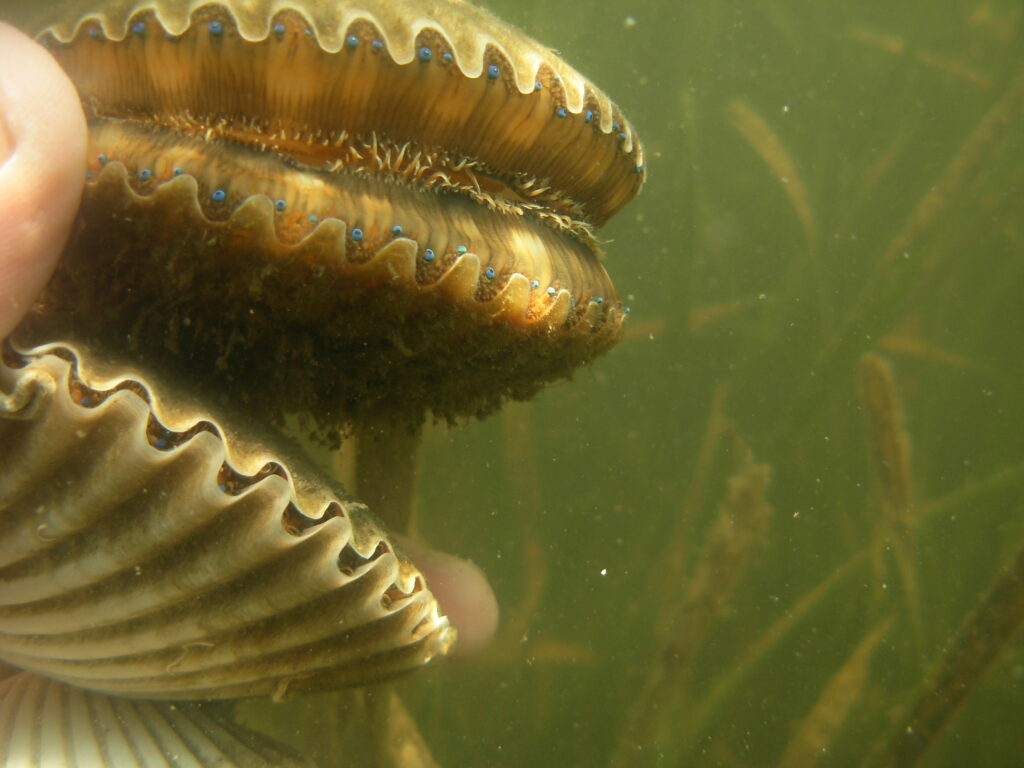
Argopecten irradians aka bay scallops, can be found near seagrass beds, especially along the Big Bend in Florida’s Gulf Coast.
An Argopecten irradians sits at the sandy bottom of a seagrass meadow, using 40+ brilliant blue eyes to detect nearby scavengers beyond brackish waters. The ocular description and scientific name may fittingly allude to a mysterious Lovecraftian sea creature, but it belongs to no other than the beloved Florida bay scallop.
Many marine animals, such as pinfish and stone crabs, pine after the scallop’s savory adductor muscle, while thousands of locals and visitors grab their snorkels and mesh bags in search of the treasured bivalve.
Today, the recreational harvest of bay scallops contributes an annual multi-million dollar economic impact in Florida’s Nature Coast and Big Bend Region -including the counties of Dixie, Levy, Taylor, Citrus, Hernando, and Pasco – supporting the livelihoods of many rural and coastal communities along the coasts.
“It’s kind of like an underwater Easter egg hunt. People from all over look forward to it every year,” says Savanna Barry, Florida Sea Grant’s Regional Specialized Extension Agent for the Nature Coast.“Sometimes, you see three generations out here for the weekend including grandparents, parents, and grandkids. It’s a family-friendly fishery, and there are a lot of charter captains that run scallop charters to make it accessible for everyone to enjoy.”
Scavenging for Scallops
Scallops were once scattered around Palm Beach to Pensacola, supporting the recreational and commercial fishery. Within a few decades, scallop populations began to dwindle, and harvesting regulations tightened in the 80s, with the eventual commercial fishery ban in 1994. Today, healthy populations of bay scallops are only found in select locations along the Big Bend.
“About 20 years ago, my wife and I went snorkeling in the early spring near Gulf Island National Seashore, and the bottom was completely covered with scallops in just one spatial area,” says Rick O’Connor, Florida Sea Grant’s UF/IFAS Extension Agent for Escambia County. “Right now we don’t see that mass number of scallops like we did 20 years ago, here in Pensacola.”
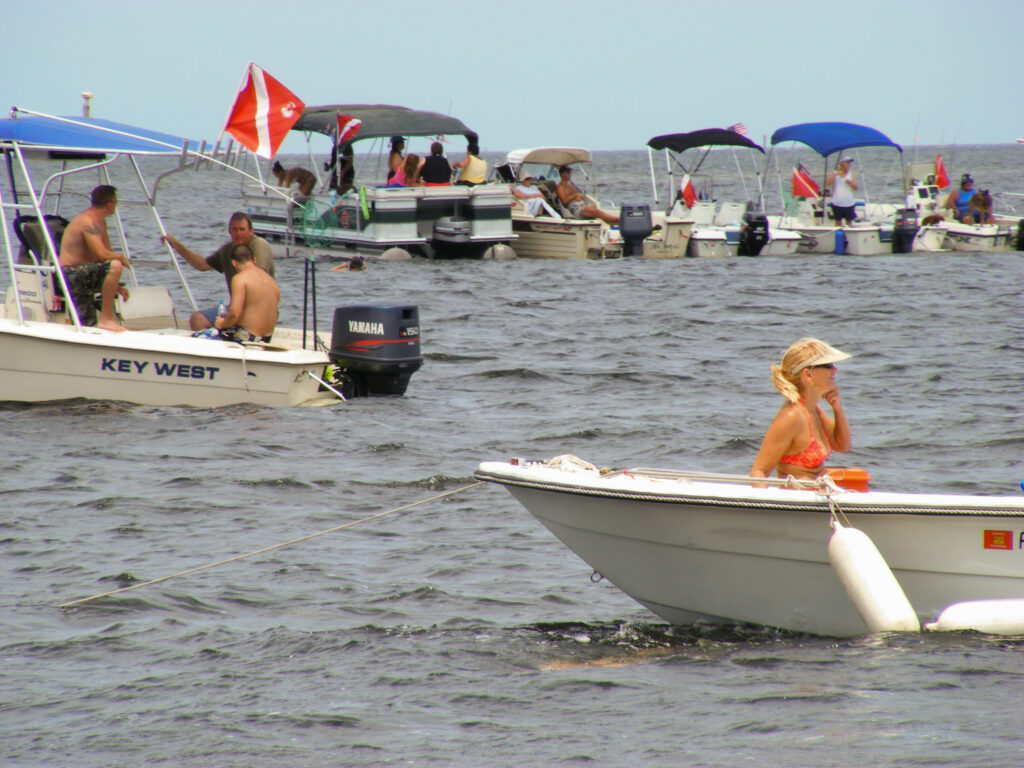
Recreational scalloping activities in the Steinhatchee area of Taylor County. Image courtesy of Tommy Thompson.
O’Connor also manages a team of “Scallop Searchers” – a group of local volunteer snorkelers who determine the presence of scallops by monitoring nearby waters.
“In the last six years, averaging somewhere between 50 and 100 volunteers, we’ve only found three scallops”.
Fortunately, volunteers have found 4 scallops in the Pensacola Bay this year – more than all previous years combined!
Just 100 miles south of Pensacola, counties such as Gulf, Levy, Hernando, Taylor, and Pasco are bustling with boats between July and September during the scallop season. In Port St. Joseph, where the population does not exceed over 3,600, a decent share of scallopers flock to the quaint coastal town for their summertime harvest and the annual Florida Scallop Festival.
“It is an exciting time of the year,” says Port St. Joe resident Murray Cornwell. “Off-season, you may see one or two boats a day, but due to the accessible sandbars and the shallow bay, you can find anywhere from 30 to 50 boats during the scallop season.”
Since bay scallops are integral to the culture and economy of rural and coastal communities, it is only imperative to acknowledge the foreseeable impacts and challenges caused by shifting oceanic and climate conditions. Florida Sea Grant, Florida Fish and Wildlife Conservation Commission (FWC), state agencies, and local community partners are developing diverse and collaborative approaches to sustain the bay scallop fishery.
Sometimes, you see three generations out here for the weekend including grandparents, parents, and grandkids. It’s a family-friendly fishery, and there are a lot of charter captains that run scallop charters to make it accessible for everyone to enjoy.
Savanna Barry
Impacts of Climate, Water Quality, and Harvesting
Bay scallops are indicator species that reflect environmental conditions including sediment loads, oxygen levels, salinity, and temperature. The presence of abundant scallops in an area is reflective of a healthy system! At the same time, scallops are susceptible to shifts in oceanic and climate conditions. In some regions of Florida, scallops have succumbed to decreases in salinity, especially in the Pensacola region.
Historically, Pensacola received 60” of rain a year. In the last decade that has increased to 70”, with the average rainfall increasing in 2017 and 2018.
“We are not sure if rainfall is solely decreasing salinity at this point, but we do know from citizen science monitoring that certain seagrass species that scallops depend on are being impacted,” says O’Connor.
Environmental conditions coupled with the relatively short life span of bay scallops cause concerns about the population’s stability.
Bay scallops found in higher latitudes along the East Coast of the United States live up to four years. In Florida, they only live for 12-18 months. Bay Scallops are hermaphrodites – meaning they can produce both eggs and sperm. And although they are capable of releasing millions of eggs at once, only one egg out of 12 million is likely to reach adulthood.
The recreational harvest occurs between July through September, with open and end dates varying throughout harvesting regions. At this time, most scallops are fully grown. However, scallops typically reproduce during the fall when the temperatures are cooler, leaving some scallops without a chance to reproduce and replenish the local scallop population.
“What’s the point of leaving the scallop, if they are going to die soon anyway?”
Besides searching for scallops, Florida Sea Grant’s UF/IFAS Extension Agent for Hernando County Brittany Hall-Scharf sometimes finds scallopers “shucking” for the rationale behind scallop conservation efforts.
“If you take everything before they can reproduce, you’re hurting next year’s season,” says Hall-Scharf. “ In my area of Florida, based on the scallop’s length and height, the spat – or juvenile scallop – grows about 0.2 mm per day. This information allows us to trace when the scallop was spawned and how old it was, making us aware of which scallops to leave behind.”
Current regulations of the Florida Fish and Wildlife Conservation Commission include:
- The recreational harvests of scallops are limited to specific zones within state waters. The open season dates differ within each zone, with some recreational seasons going into September, while others end in August.
- There are personal and vessel bag limits, varying within regional zones.
- Harvesting of scallops must only be done by hand or by using a landing or dip net.
Currently, there is no size requirement.
Take the Sorter, Leave the Scallop
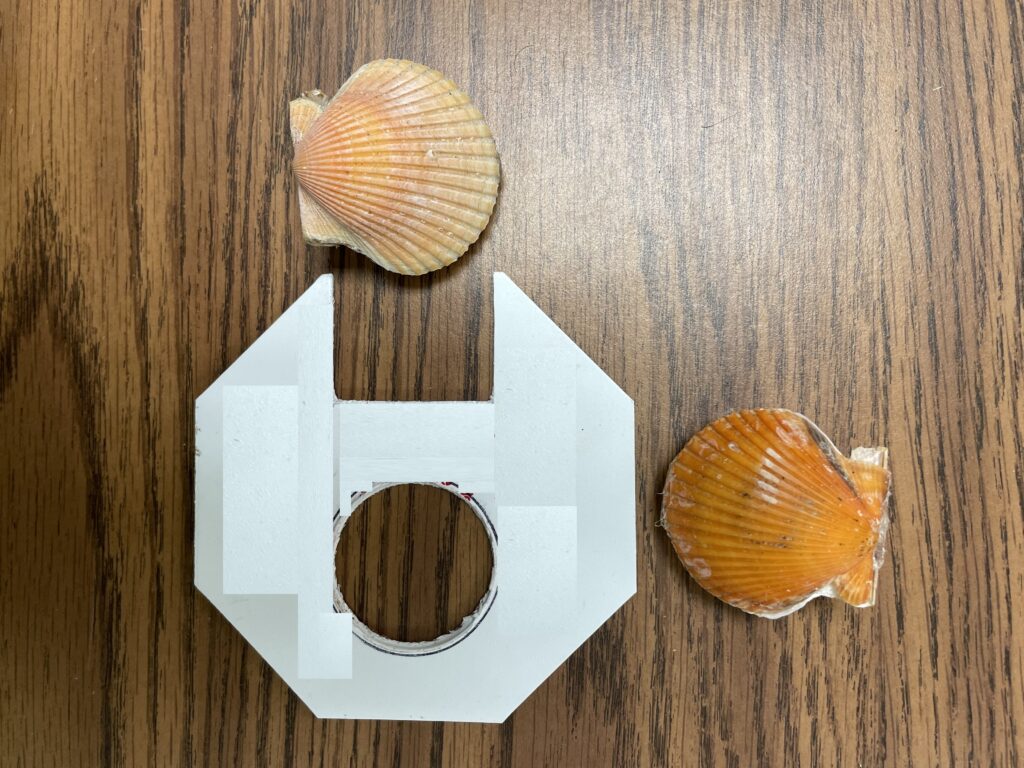
Early design prototypes for the scallop sorters were discussed with charter captains and stakeholders.
In the Taylor and Hernando area, summers are all about scalloping! Recreational harvesting is an important economic driver in the area. The 2017 scallop season generated an estimated economic impact of $1.1 million in Hernando, while a 2018 study extrapolated an economic impact of $1.8 million in the Steinhatchee area.
Extension agents throughout Hernando, Citrus, Levy, Pasco, Bay, Gulf, and Taylor counties host an annual Scallop Seminar in their local community to inform the public about the most up-to-date information on the scallop population, scallop habitat conservation, harvesting good practices, and boating safety.
In response to also devising a coherent scallop fishery approach for areas like Steinhatchee,
Florida Sea Grant’s UF/IFAS Extension Agent for Taylor County, Victor Blanco , initiated the idea of an effective non-regulatory harvesting tool. Eventually, the concept of a pocket-size scallop sorter that can be used underwater came to fruition.
“I initiated the scallop sorter discussion with local charter captains in Taylor County in February 2022, and presented different options and prototypes of tools including the “gallon shaker”, the “notch gauge”, and the “hole gauge”, says Blanco.
“Charter captains and stakeholders recommended a 2-inch hole sorter tool. The original idea was a 2-inch hole in a solid and floating material that could be attached to the mesh bag, allowing to sort the scallops as they were harvested. This allowed me to initiate the creation of a sticker with UF IFAS, that included educational info for sorting scallops.”
Blanco worked with Hernando’s Hall-Scharf and stakeholders in their respective counties to develop prototypes, and after some time, both agents reconvened with feedback on the size, shape, connector piece, and design. Florida Sea Grant provided funds to produce and distribute a sorter tool, in which Hall-Scharf partnered with a local Hernando manufacturing company, PED-Stuart, to produce the sorters.
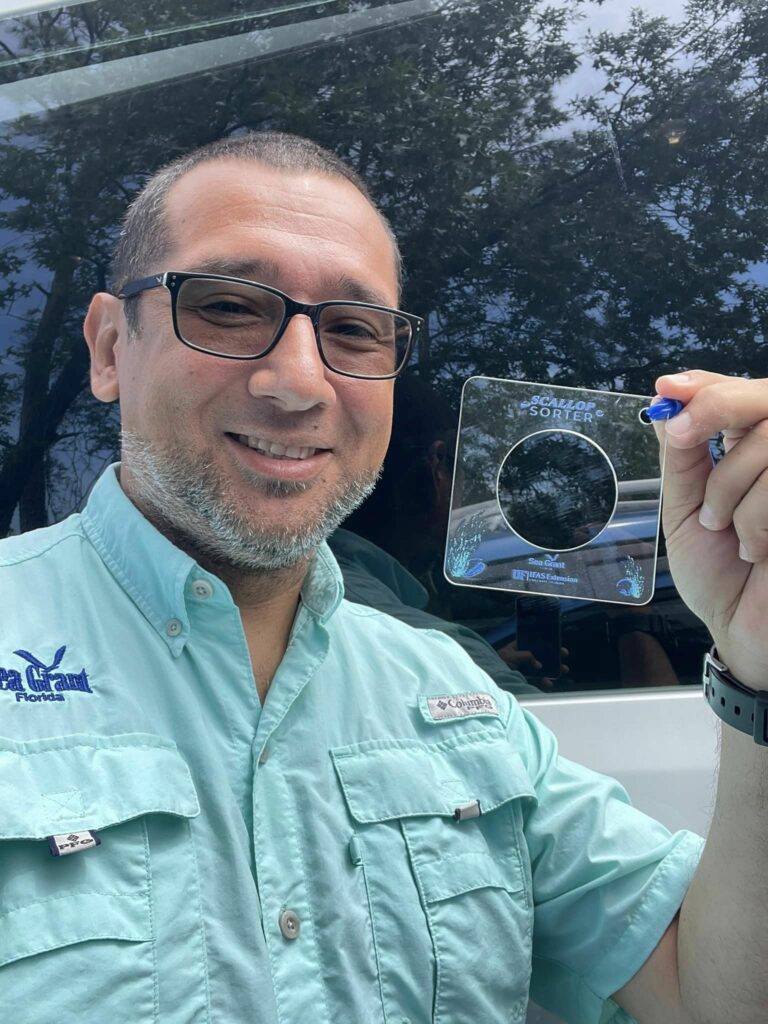
Taylor County extension agent, Victor Blanco, pictured with the final design of the scallop sorter that were distributed in 2022. Image courtesy of Victor Blanco.
Historically, scallopers would use the bottoms of soda cans to measure juvenile and adult scallops.
“Keeping larger scallops has been a recommended practice before I started with Florida Sea Grant in 2016. However, Victor and I felt it was important to have a tool you could use underwater so that the scallops wouldn’t sit on a boat deck in the sun and die,” says Hall-Scharf.
The scallop sorters rolled out in 2022, with an initial diameter of 1.5 inches, per biologist recommendations. In 2022, 829 users received the scallop sorter tools (396 in Hernando, 412 in Taylor, and 21 in Gulf County). Follow-up surveys indicated that 74.5% of recreational anglers and charter captains voluntarily implemented the tool during scallop trips between July 1 and September 23, 2022.
After post-survey feedback, the public recommended increasing the size of the tool from the size of the sorting hole from 1.5 inches to 2 inches so that more scallops are left behind to reproduce. Feedback was shared with state resource managers for decisions regarding upcoming scallop seasons and regions.
After the results from the test pilot in 2022 in Taylor and Hernando County, the adoption of the tool went well into 2023, with over 2000 sorters distributed throughout Taylor, Hernando, Citrus, and Pasco counties this season.
“While there is no regulated size requirement, the release of the smaller scallops is a voluntary but recommended practice. It’s important to know what we do this season is going to affect next year’s season,” says Hall-Scharf.
Diminishing Populations Call for Diverse Strategies
While many participate in the sustainable harvest of bay scallops, a group of local volunteers deemed Scallop Sitter Volunteers contribute to restoration efforts across the Big Bend region.
Scallops are collected during the annual FWC’s Scallop Rodeo, where volunteers collect up to 200 scallops each. “Scallops are taken back to the FWC hatchery, where the broodstock is used to supply most predatory exclusion cages used by both FWC Biologists and Scallop Sitter Volunteers – Hernando scallop sitters use wild-caught scallops and place them directly into their cages. This stock helps to replenish populations and protect the genetic variability,” says Ray Bodrey, Florida Sea Grant’s UF/IFAS Extension Agent for Gulf County.
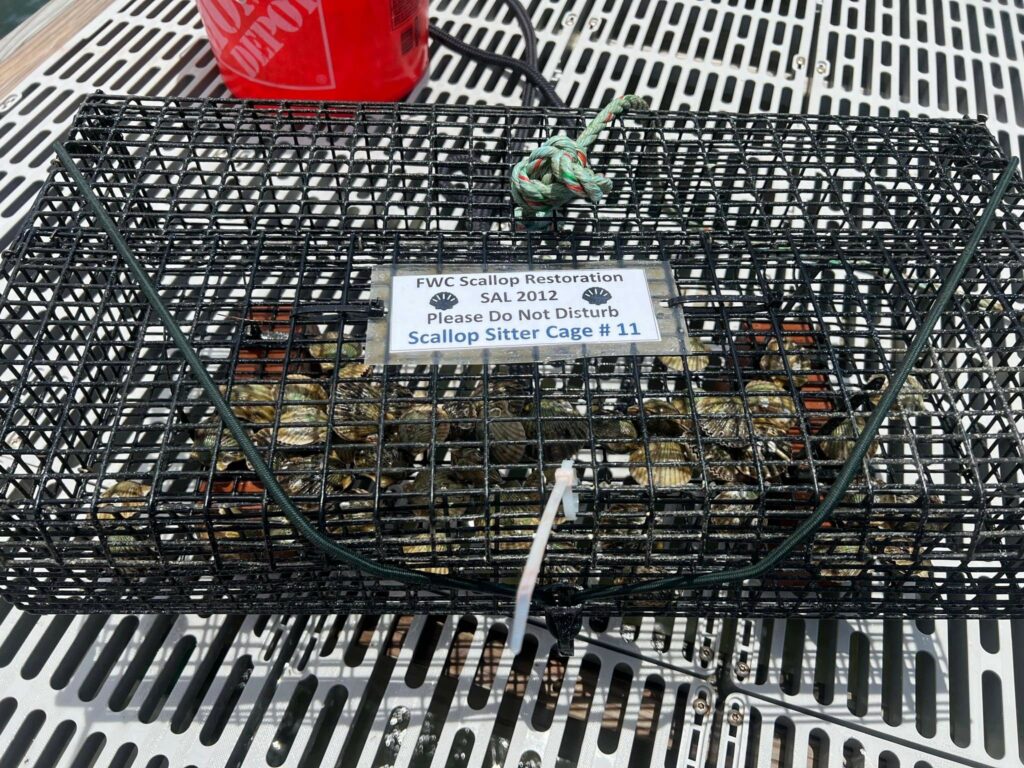
Scallop sitter cage in Port St. Joseph. Image courtesy of Murray Cornwell.
The goals of the Scallop Sitter Volunteer Program are to increase recruitment of the bay scallop population in local waters and identify suitable areas for additional restoration by determining the salinity and survivability of the caged scallop.
Starting in June, volunteers place their assigned cages by nearby docks or in the bay. Monthly visits are made, where they clean the scallops and collect data on water salinity and scallop mortality.
“Well, it’s kind of like taking care of a plant,” says first-time sitter Kendra Jacoby. “But it is also part of the bigger picture. We are trying to take care of our environment and save what we have left.”
In January, cages and data are returned to scientists at FWC to determine restoration goals and the success of targeted restoration areas. The collected data gives FWC an idea about the population before the season starts again.
Overall, 12,370 scallops total were collected during the program, with 3,850 scallops managed in 2022. The program has also been effective in enhancing the environmental literacy of local participants.
“In my first year of being a sitter, I could just walk out into the bay, and there were hundreds of scallops. The second year, there were only about a dozen or so, but then I went further afield, and we found them in the state park where they weren’t the year before,” says Murray Cornwell.
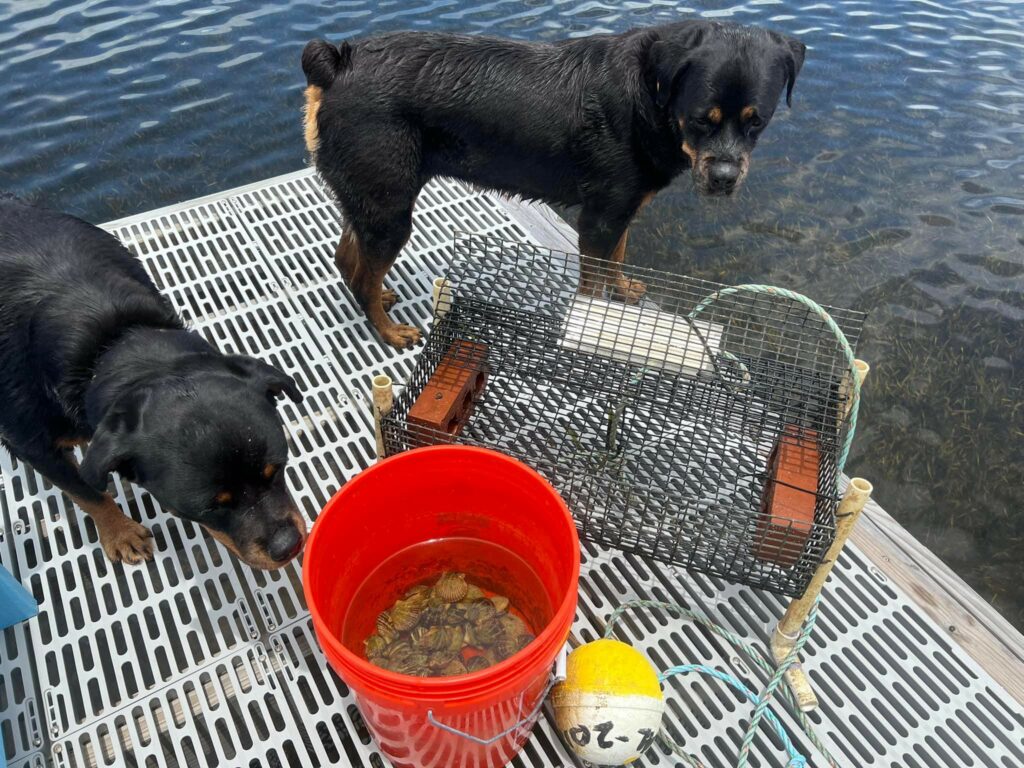
Scallops from the cage are cleaned and monitored by Scallop Sitter volunteer Murray Cornwell and friends. Images courtesy of Murray Cornwell.
For Kendra Jacoby, being a part of the Scallop Sitters program heightened her situational awareness of the changing environment.
“In the past three years that we’ve been here, I’ve noticed the amount of seagrass has changed. On our very first day out with the cage, we were trying to find some seagrass to put it beside, but we could not find any sections on the beach,” says Jacoby.
Seagrass is highly associated with scallops, providing essential refuge and forage habitats. Seagrasses are often dominant in estuaries with soft sediments and clear water conditions and thrive off conditions similar to scallops including high oxygen, salinity levels between 20-30 ppt, and low sediment turbidity.
“When the commercial fishery was open, harvesters would trawl over seagrass beds to find scallops – anywhere there was seagrass, there were scallops,” says Barry. “Now, scallop populations are restricted to the Big Bend area because that’s where we have the largest continuous area of persistent, healthy seagrasses in the eastern Gulf.”
Other monitoring programs such as Eyes on Seagrass may not be solely focused on scallop restoration, but are essential in providing data on seagrass and sediment presence, salinity, and water quality – all conditions ideal for scallops. And although many projects and programs are in their initial stages of scallop restoration and conservation, these efforts collectively support the work of each other.
Like most marine organisms, the health of scallops is dependent on the health of the environment. To address the vulnerabilities of the current bay scallop population, a multifaceted approach that includes water quality monitoring, stormwater management, seagrass restoration, and sustainable harvesting practices is necessary to protect these delectable, yet delicate bivalves.